python分句
Python中的循环 (Loops in Python)
forloopfor循环whileloopwhile循环
Let’s learn how to use control statements like break, continue, and else clauses in the for loop and the while loop.
让我们学习如何在for循环和while循环中使用诸如break , continue和else子句之类的控制语句。
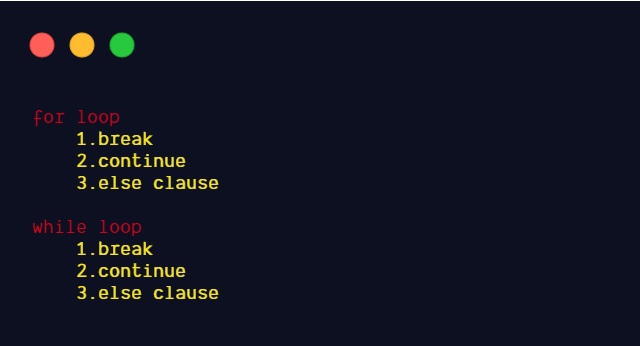
声明 (‘for’ Statement)
The for statement is used to iterate over the elements of a sequence (such as a string, tuple, or list) or any other iterable object.
for语句用于遍历序列的元素(例如字符串,元组或列表)或任何其他可迭代对象。
for item in iterable:
suite- The iterable is evaluated only once. An iterator is created for the result of that iterable. 可迭代仅被评估一次。 为该可迭代的结果创建一个迭代器。
- The suite is then executed once for each item provided by the iterator, in the order returned by the iterator. 然后按迭代器返回的顺序对迭代器提供的每个项目执行一次套件。
- When the items are exhausted, the loop terminates. 物品用完后,循环终止。
例子1.'for'循环 (Example 1. ‘for’ loop)
for i in range(1,6):
print (i)'''
Output:
1
2
3
4
5
'''The for loop may have control statements like break andcontinue, or the else clause.
for循环可能具有控制语句,例如break和continue或else子句。
There may be a situation in which you may need to exit a loop completely for a particular condition or you want to skip a part of the loop and start the next execution. The for loop and while loop have control statements break and continue to handle these situations.
在某些情况下,您可能需要针对特定条件完全退出循环,或者想要跳过循环的一部分并开始下一次执行。 for循环和while循环的控制语句break并continue处理这些情况。
“中断”声明 (‘break’ Statement)
The break statement breaks out of the innermost enclosing for loop.
break语句脱离了最里面的for循环。
A break statement executed in the first suite terminates the loop without executing the else clause’s suite.
在第一个套件中执行的break语句将终止循环,而不执行else子句的套件。
The break statement is used to terminate the execution of the for loop or while loop, and the control goes to the statement after the body of the for loop.
break语句用于终止for循环或while的执行 循环,然后控制转到for循环主体之后的语句。
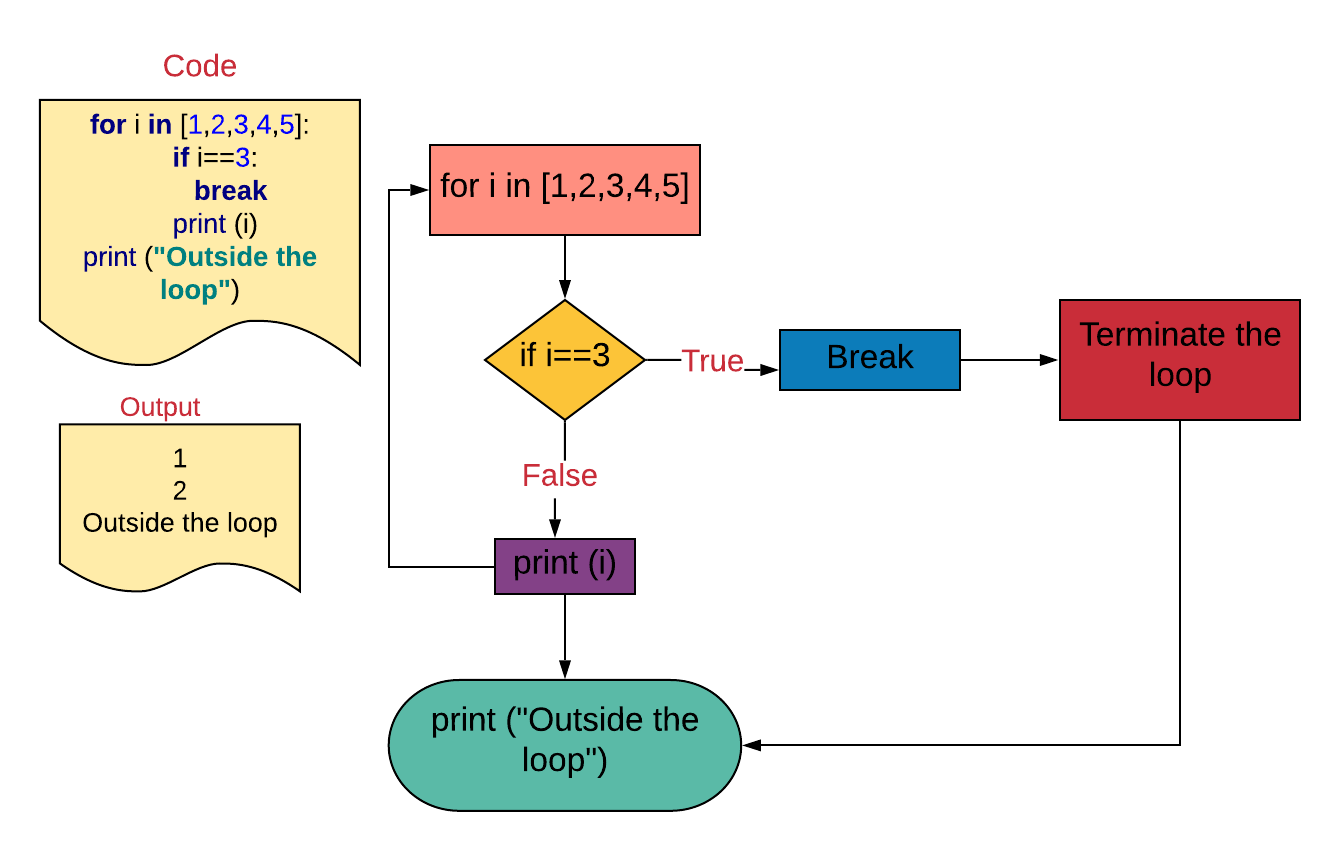
示例2.在“ for”循环中使用“ break”语句 (Example 2. Using the ‘break’ statement in a ‘for’ loop)
The
forloop will iterate through the iterable.for循环将迭代可迭代对象。If the item in the iterable is
3, it will break the loop and the control will go to the statement after theforloop, i.e.,print (“Outside the loop”).如果iterable中的项目为
3,它将中断循环,并且控件将在for循环后转到语句,即print (“Outside the loop”)。If the item is not equal to
3, it will print the value, and theforloop will continue until all the items are exhausted.如果该项不等于
3,它将打印该值,并且for循环将继续进行,直到用尽所有项。
for i in [1,2,3,4,5]:
if i==3:
break
print (i)
print ("Outside the loop")'''
Output:
1
2
Outside the loop
'''例子3.在带有“ else”子句的“ for”循环中使用“ break”语句 (Example 3. Using the ‘break’ statement in a ‘for’ loop having an ‘else’ clause)
A break statement executed in the first suite terminates the loop without executing the else clause’s suite.
在第一个套件中执行的break语句将终止循环,而不执行else子句的套件。
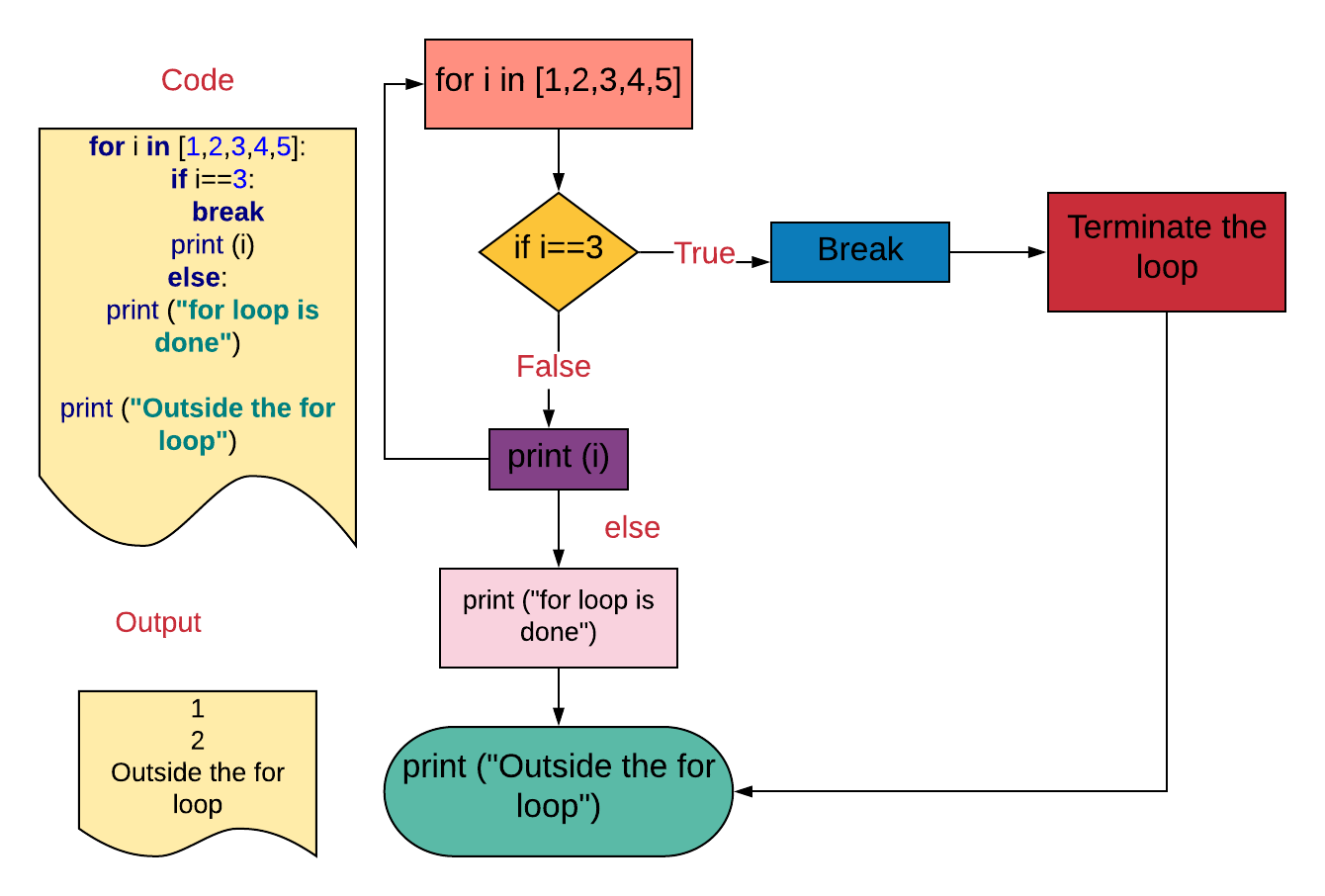
Example:
例:
In the for loop, when the condition i==3 is satisfied, it will break the for loop, and the control will go to the statement after the body of the for loop, i.e., print (“Outside the for loop”).
在for循环中,当满足条件i==3 ,它将中断for循环,并且控制将进入for循环主体之后的语句,即print (“Outside the for loop”) 。
The else clause is also skipped.
else子句也被跳过。
for i in [1,2,3,4,5]:
if i==3:
break
print (i)else:
print ("for loop is done")
print ("Outside the for loop")'''
Output:
1
2
Outside the for loop
'''“继续”声明 (‘continue’ Statement)
The continue statement continues with the next iteration of the loop.
continue语句继续执行循环的下一个迭代。
A continue statement executed in the first suite skips the rest of the suite and continues with the next item or with the else clause, if there is no next item.
在第一个套件中执行的continue语句将跳过套件的其余部分,并继续执行下一项或else子句(如果没有下一项)。
例子4.在“ for”循环中使用“ continue”语句 (Example 4. Using the ‘continue’ statement in a ‘for’ loop)
The
forloop will iterate through the iterable.for循环将迭代可迭代对象。If the item in the iterable is
3, it will continue theforloop and won’t execute the rest of the suite, i.e.,print (i).如果iterable中的项目为
3,它将继续for循环,并且将不执行套件的其余部分,即print (i)。So element
3will be skipped.因此元素
3将被跳过。The
forloop will continue execution from the next element.for循环将从下一个元素继续执行。The
elseclause is also executed.else子句也将执行。
for i in [1,2,3,4,5]:
if i==3:
continue
print (i)else:
print ("for loop is done")
print ("Outside the for loop")'''
1
2
4
5
for loop is done
Outside the for loop
'''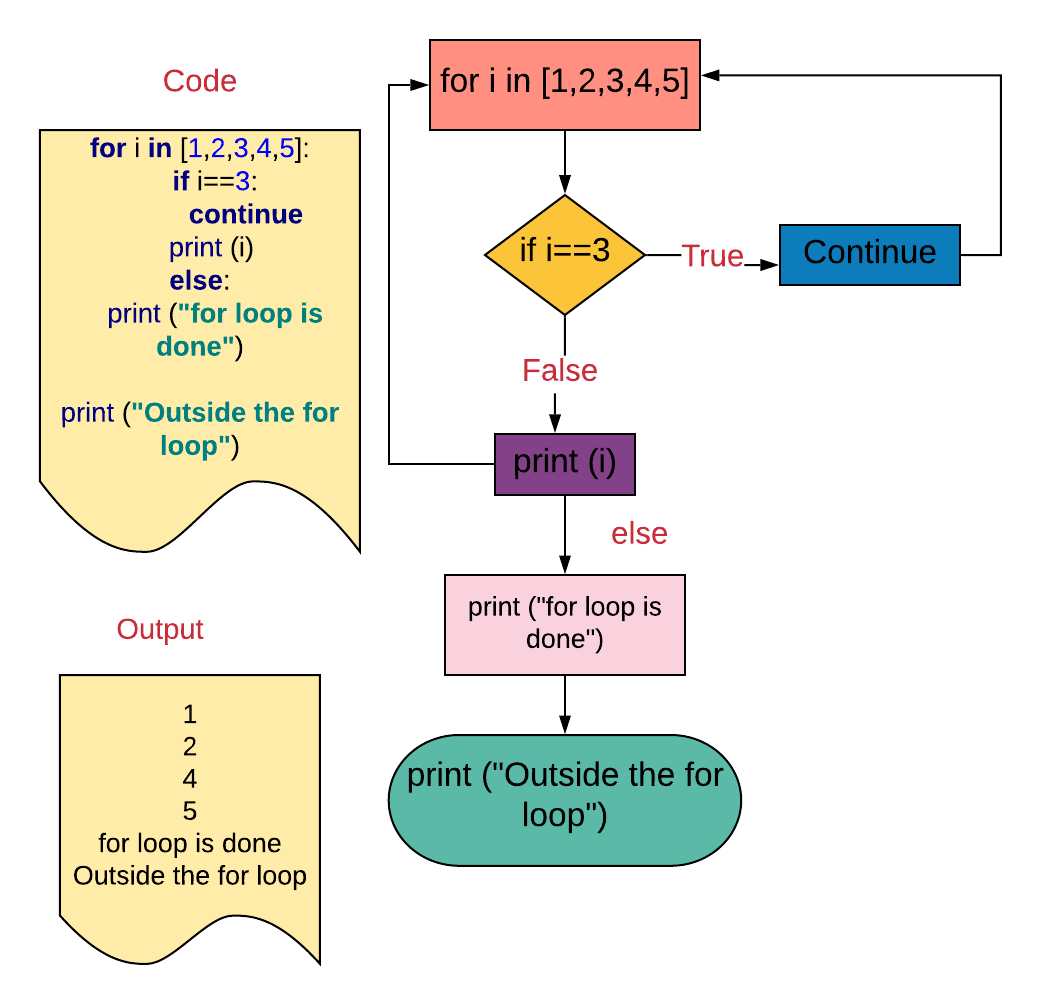
for循环中的else子句 (‘else’ Clause in ‘for’ Loop)
Loop statements may have an else clause. It is executed when the for loop terminates through exhaustion of the iterable — but not when the loop is terminated by a break statement.
循环语句可能包含else子句。 当for循环通过迭代器的穷尽而终止时,将执行该语句,但当该循环由break语句终止时,则不会执行该语句。
例子5.在“ for”循环中使用“ else”子句 (Example 5. Using the ‘else’ clause in a ‘for’ loop)
The else clause is executed when the for loop terminates after the exhaustion of the iterable.
当for循环在迭代器用尽后终止时,将执行else子句。
for i in [1,2,3,4,5]:
print (i)else:
print ("for loop is done")
print ("Outside the for loop")'''
1
2
3
4
5
for loop is done
Outside the for loop
'''例6.在“ for”循环中使用“ break”语句使用“ else”子句 (Example 6. Using the ‘else’ clause in a ‘for’ loop with the ‘break’ statement)
The else clause is not executed when the for loop is terminated by a break statement.
当for循环由break语句终止时, else子句不会执行。
for i in [1,2,3,4,5]:
if i==3:
break
print (i)else:
print ("for loop is done")
print ("Outside the for loop")'''
1
2
Outside the for loop
'''示例7.在“ for”循环中使用“ continue”语句使用“ else”子句 (Example 7. Using the ‘else’ clause in a ‘for’ loop with the ‘continue’ statement)
The else clause is also executed.
else子句也将执行。
for i in [1,2,3,4,5]:
if i==3:
continue
print (i)else:
print ("for loop is done")
print ("Outside the for loop")'''
1
2
4
5
for loop is done
Outside the for loop
'''例子8.在“ for”循环中使用“ break”语句和“ else”子句 (Example 8. Using the ‘break’ statement and ‘else’ clause in a ‘for’ loop)
Search the particular element in the list. If it exists, break the loop and return the index of the element; else return “Not found.”
搜索列表中的特定元素。 如果存在,则中断循环并返回该元素的索引;否则,返回0。 否则返回“未找到”。
l1=[1,3,5,7,9]def findindex(x,l1):
for index,item in enumerate(l1):
if item==x:
return index
break
else:
return "Not found"print (findindex(5,l1))#Output:2print (findindex(10,l1))#Output:Not found“ while”循环 (‘while’ Loop)
The while statement is used for repeated execution as long as an expression is true.
只要表达式为真, while语句将用于重复执行。
while expression:
suiteelse:
suiteThis repeatedly tests the expression and, if it is true, executes the first suite. If the expression is false (which it may be the first time it is tested) the suite of the else clause, if present, is executed and the loop terminates.
这将反复测试表达式,如果为true,则执行第一个套件。 如果表达式为假(可能是第一次测试),则执行else子句套件(如果存在)的套件,并终止循环。
例子9.在“ while”循环中使用“ else”子句 (Example 9. Using the ‘else’ clause in a ‘while’ loop)
The while loop is executed until the condition i<5 is False.
执行while循环,直到条件i<5为False。
The else clause is executed after the condition is False.
条件为False后执行else子句。
i=0while i<5:
print (i)
i+=1else:
print ("Element is not less than 5")'''
Output:
0
1
2
3
4
Element is not less than 5
'''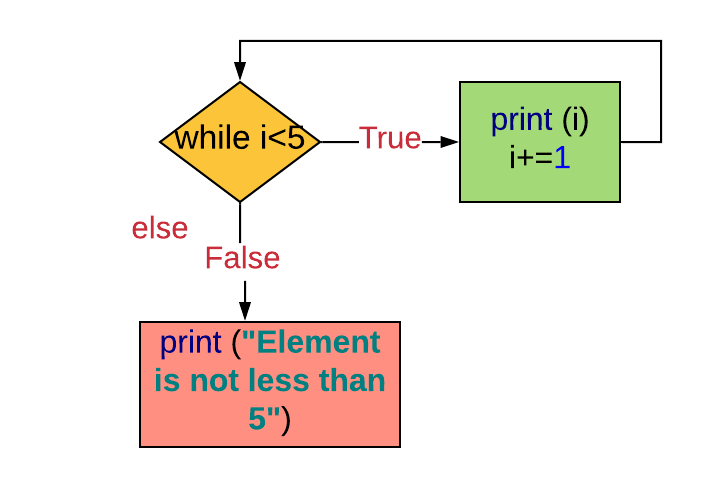
“中断”声明 (‘break’ Statement)
A break statement executed in the first suite terminates the loop without executing the else clause’s suite.
在第一个套件中执行的break语句将终止循环,而不执行else子句的套件。
例子10.在“ while”循环中使用“ break”语句和“ else”子句 (Example 10. Using the ‘break’ statement and ‘else’ clause in a ‘while’ loop)
The break statement terminates the loop and the else clause is not executed.
break语句终止循环,而else子句未执行。
i=0while i<5:
print (i)
i+=1
if i==3:
break
else:
print ("Element is not less than 5")'''
Output:
0
1
2
'''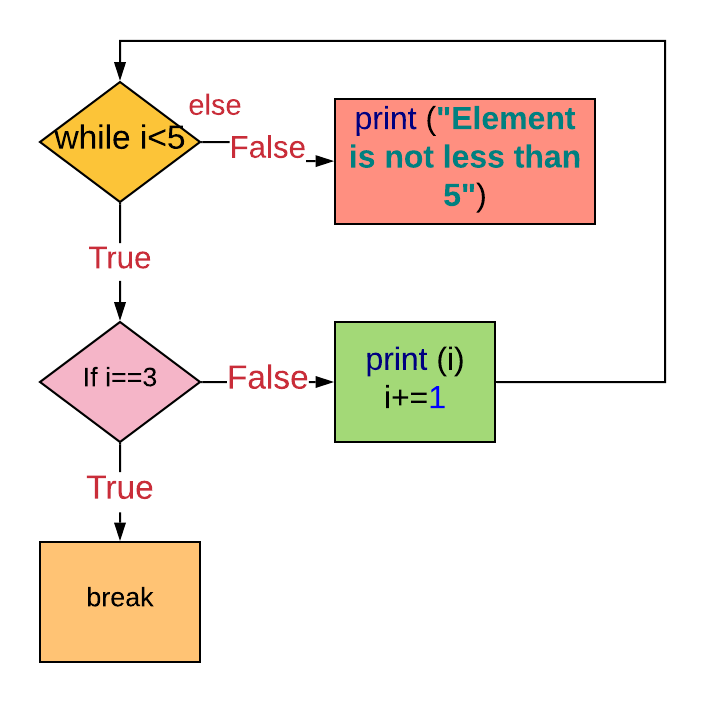
“继续”声明 (‘continue’ Statement)
A continue statement executed in the first suite skips the rest of the suite and goes back to testing the expression.
在第一个套件中执行的continue语句将跳过套件的其余部分,然后返回测试表达式。
例子11.在“ while”循环中使用“ continue”语句和“ else”子句 (Example 11. Using the ‘continue’ statement and ‘else’ clause in a ‘while’ loop)
The continue statement skips the part of the suite when the condition i==3 is True. The control goes back to the while loop again.
当条件i==3为True时, continue语句将跳过套件的一部分。 控件再次返回while循环。
The else clause is also executed.
else子句也将执行。
i=0while i<5:
print (i)
i+=1
if i==3:
continue
else:
print ("Element is not less than 5")'''
Output:
0
1
2
3
4
Element is not less than 5
'''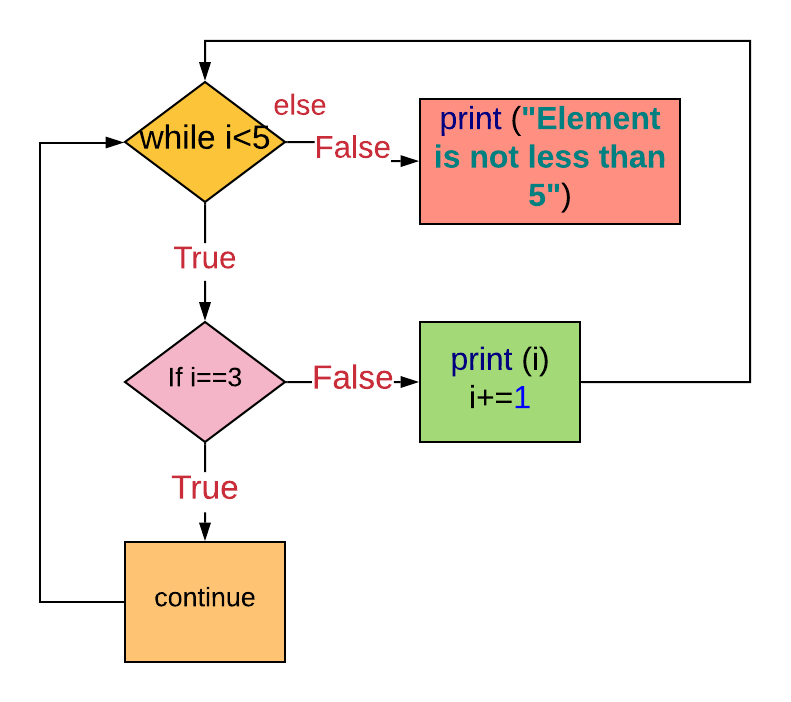
结论 (Conclusion)
Python version used is 3.8.1.
使用的Python版本是 3.8.1。
The
breakstatement will terminate the loop (bothforandwhile). Theelseclause is not executed.break语句将终止循环(for和while)。else子句不执行。The
continuestatement will skip the rest of the suite and continue with the next item or with theelseclause, if there is no next item.如果没有下一个项目,则
continue语句将跳过套件的其余部分,并继续下一个项目或else子句。The
elseclause is executed when theforloop terminates after the exhaustion of the iterable.当
for循环在迭代器用尽后终止时,将执行else子句。
资源(Python文档) (Resources (Python Documentation))
break and continue Statements, and else Clauses on Loops
break 并 continue 语句, else 循环中的子句
break statement in Python
Python中的 break 语句
continue statement in python
在python中的 continue 语句
for statement in python
for python中的语句
翻译自: https://medium.com/better-programming/break-continue-and-else-clauses-on-loops-in-python-b4cdb57d12aa
python分句
本文来自互联网用户投稿,该文观点仅代表作者本人,不代表本站立场。本站仅提供信息存储空间服务,不拥有所有权,不承担相关法律责任。如若转载,请注明出处:http://www.mzph.cn/news/388127.shtml
如若内容造成侵权/违法违规/事实不符,请联系多彩编程网进行投诉反馈email:809451989@qq.com,一经查实,立即删除!
![[翻译 EF Core in Action 2.0] 查询数据库](http://pic.xiahunao.cn/[翻译 EF Core in Action 2.0] 查询数据库)
















)
